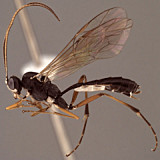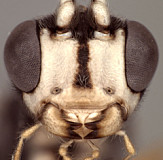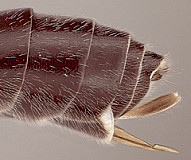Clypeus (Fig. 2) broad, surface nearly smooth to distinctly punctate; with transverse bulge, the ventral margin sharp, weakly to strongly impressed below the bulge; ventral margin highly variable in shape from evenly convex to truncate as in Fig. 2, to medially concave; when truncate or concave, lateral portion angled dorsally as in Fig. 2; epistomal sulcus varying from distinctly delineated as in Fig. 2 to broad, shallow, poorly indicated; clypeus in profile weakly protruding. Inner eye margins parallel. Malar space (Fig. 2) varying from about 0.5-1.0 times basal width of mandible; malar sulcus absent. Mandible (Fig. 2) long, tapering gradually from base to apex or with apical 0.5 more or less parallel-sided; ventral tooth equal in length or very slightly longer than dorsal tooth; ventral margin distinctly carinate. Maxillary palp equal to or slightly shorter than height of head; antenna (Fig. 3) usually as long as or longer than body; first flagellomere usually very long. Ocelli small, diameter of lateral ocellus less than distance from lateral ocellus to eye. Hypostomal carina meeting occipital carina well above base of mandible; occipital carina complete dorsally. Epomia present in most species examined; many species with anterior portion of pronotum abruptly elevated as seen in profile. Epicnemial carina reaching anterior margin of mesopleuron in nearly all (90%) of species examined. Notaulus present on anterior declivity usually as a distinct impression, rarely sculptured, becoming more faint and on disk where it is short in some species, not extending to tegula, and long in others, reaching posterior margin or large, median-posterior depression, but never deeply impressed posteriorly. Groove between propodeum and metapleuron absent to weakly indicated, not u-shaped as in pionines; pleural carina present, well-developed throughout in some species, weak to absent or nearly so posteriorly in others; propodeal carinae completely absent in some species; otherwise, median longitudinal carinae parallel-sided, often narrowly so, when present, often absent or present only at extreme apex, lateral longitudinal carina absent or incomplete, rarely extending from posterior margin as far anteriorly as spiracle, transverse carinae absent. Legs with apical margin of mid tibia only weakly expanded into a tooth: not similar to that of fore leg; apical comb on posterior side of hind tibia well-developed; posterior hind tibial spur long, nearly always more than 0.3 times length of long, thin, hind basitarsus (Figs 4, 5); tarsal claws not pectinate; fifth tarsomere of hing leg normal in size (Fig 4), only very rarely unusually elongate (relative to fourth). Fore wing (Fig. 6) usually with areolet absent, more rarely present; stigma varying among species: longer and narrower in some with Rs+2r arising near basal 0.3, shorter and broader in others, with Rs+2r arising near midpoint. Hind wing (Fig. 6) with first abscissa of CU1 longer than 1cu-a. T1 relatively long, slender (Fig. 7), never strongly expanding posteriorly; ventral margin straight or decurved in profile; dorsal carinae absent; basal depression at dorsal tendon attachment absent or nearly so; dorsal-lateral carina somewhat ventrally displaced, complete between spiracle and apex of T1; glymma absent. S1 usually extending a little posterior to level of spiracle, sometimes distinctly so. T2 thyridium distinct in nearly all species but variable in size and shape among species; laterotergites of T2 and T3 separated by creases from median tergite. Ovipositor and sheath (Fig. 8) about as in
Hadrodactylus though sometimes a bit longer; ovipositor with dorsal, subapical notch. The species are generally long and very slender.
The above description is modified from Townes (1970), and based on numerous specimens, representing at least 10 species, in the Texas A&M University collection. Townes (1970: 262, 263) provides good figures of variation, especially of the clypeus and propodeum.









